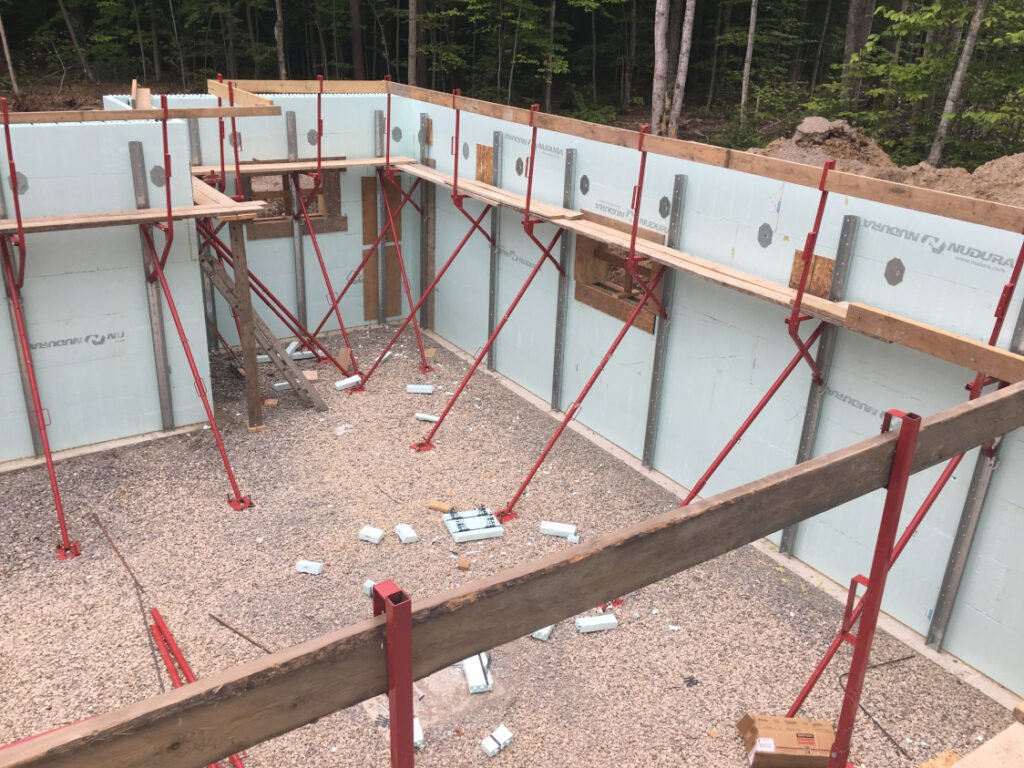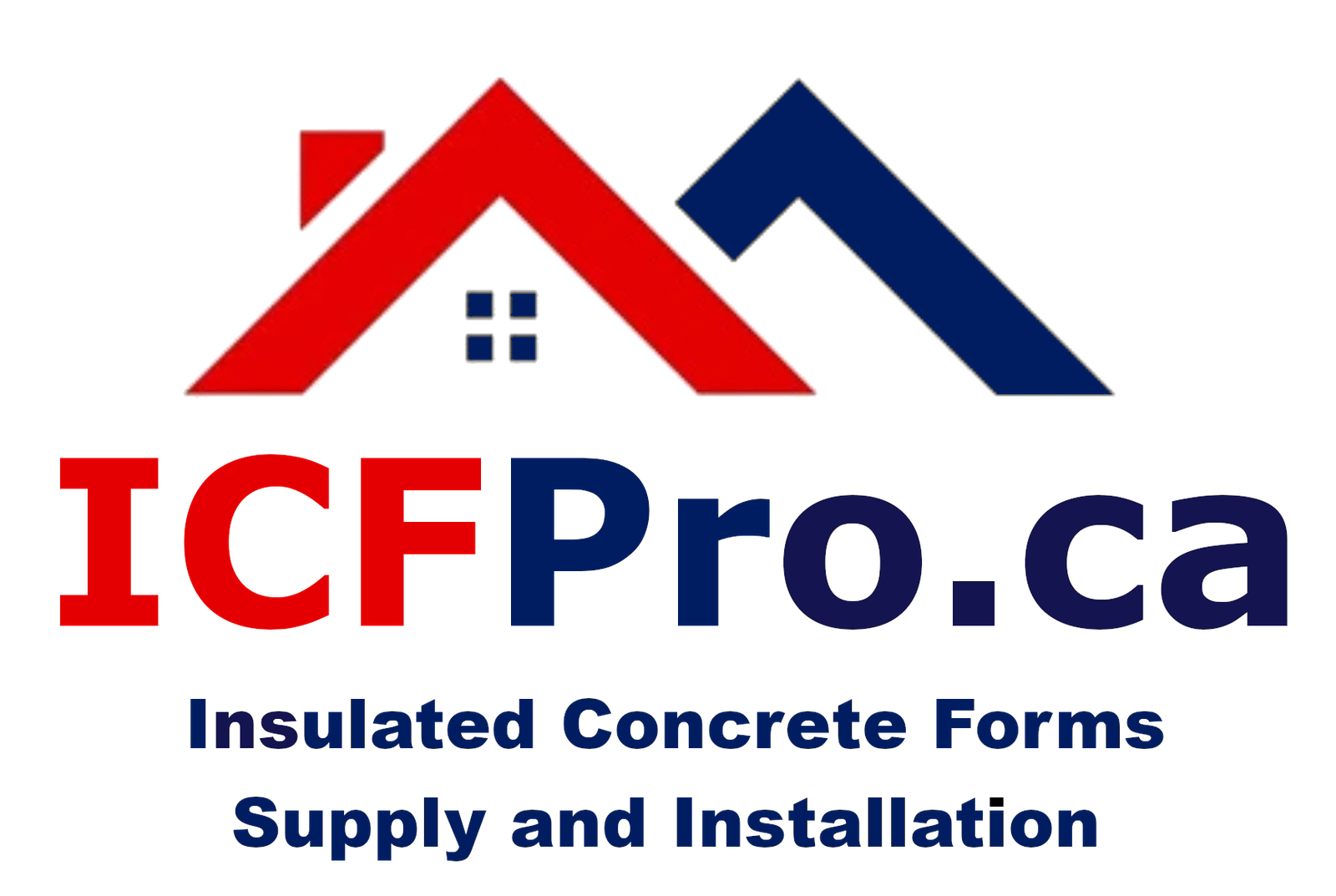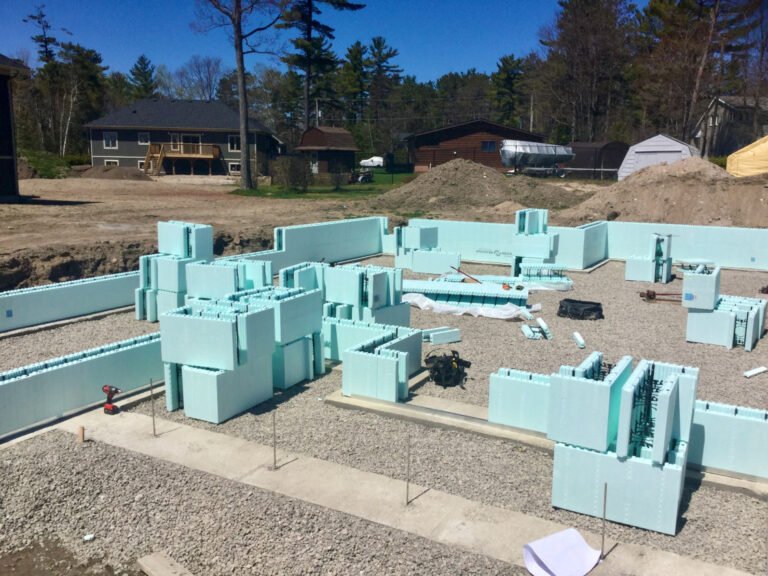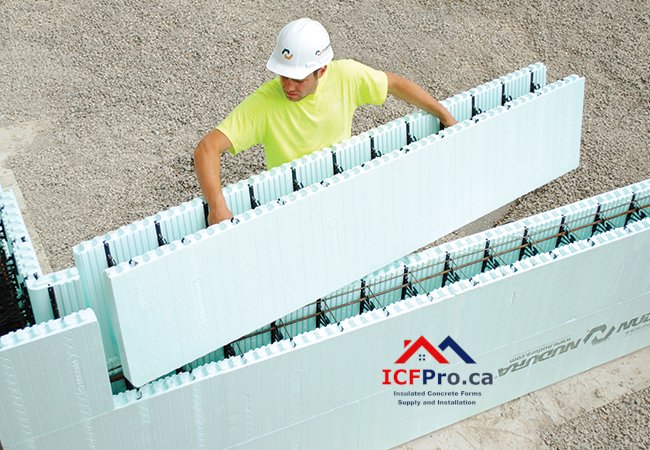ICFPro.ca is a division of ICFhome.ca - Phone 1 866 868-6606 - Direct Line 1 705 533-1633 - Email: info@icfhome.ca
Building with Insulated Concrete Forms

Welcome to the zany and slightly kooky adventure of constructing homes with insulated concrete forms (ICFs). It’s a place where construction gets a turbo boost and dollars do a happy dance.
Time-Saving Construction
Building with ICFs is like stepping into a warp zone that rushes the clock, chopping 2-4 months off how long it takes to build your home (Jenkins Design Build). Imagine watching your dream house being built like someone sat on the remote’s fast-forward button. With ICF, construction’s exterior and interior tasks become a breeze, while concrete superheroes save the day, dodging age like fine wood does not. Strap in for a wild ride that’ll have you unpacking boxes before you know it!
Cost Analysis of ICF Forms
And now, we tread into the thrilling world of dollars and cents! Building with ICF forms isn’t just speedy, it’s wallet-friendly too. These pre-assembled straight-form blocks breeze into your construction site and bid farewell to unnecessary concrete, slashing it by around 10% and shrinking expenses by roughly 25% (Pro Crew Schedule).
But hold the phone, there’s more! ICF walls are your trusty sidekicks in the battle against high energy bills, trimming heating and cooling costs by about 20%. They’re like the Zen masters of the building world, smartly storing heat in winter and letting it out in summer. Here’s a crazy fact: an ICF-walled house could spare our atmosphere around 110 tons of carbon dioxide over a century (Pro Crew Schedule). So, while you’re living your dream, you’re also giving Mother Earth a high-five.
Hop on for more in this zany journey through ICF construction, sprinkled with humor and money-saving magic. Building with ICFs – where time’s on your side, and your savings keep growing!
Benefits of Insulated Concrete Forms
When you’re thinking about swapping that flimsy drywall for something that laughs in the face of weather, Insulated Concrete Forms (ICFs) are your new best friend. Full of chuckles and insulation, these forms offer real advantages for both eco-friendly homebuyers and builders looking to construct buildings that barely notice the weather outside.
Enhanced Energy Efficiency
Using ICFs is kinda like wrapping your house in a cozy, energy-saving blanket. They have layers of insulation, inside and out, that make those heating and cooling systems do a lot less heavy lifting. That’s right, keep that wallet happy with smaller utility bills and live the dream with less energy use. It’s like getting closer to net-zero energy use without turning your home into a science experiment.
Structural Strength and Durability
If you’re after a structure that could withstand even the wildest toddler tantrum, here it is. These ICF walls are tough cookies. Buildings made with ICFs walk through life unbothered by the elements, as strong as your grandma’s fruitcake. This makes them the right pick for areas where Mother Nature likes her drama – think of protecting against fierce weather and standing tall like a hero in all its solid glory.
Soundproofing and Air Quality
In a world full of noise, ICFs are the “shush” no one saw coming. These chunky walls keep out annoying sounds like unwanted uninvited karaoke sessions next door, boasting a solid STC rating of 54. Great for maintaining peace both in homes and commercial spaces craving quiet. Plus, they’re pretty good at keeping indoor air quality top-notch. With less air slipping in and out, you get to breathe cleaner, fresher air, savoring your home like a fine wine – or maybe that’s just the sound of silence you’re enjoying.
In the grand scheme of building, ICFs bring you energy efficiency, strength, durability, soundproofing, and improved air quality. They manage to mix practicality with a good dash of humor in a world where even concrete gets a personality. So, why not welcome their charm into your construction plans?
Construction Process with ICFs
Building with insulated concrete forms (ICFs) ain’t rocket science, but there’s a method to the madness. Think of it like playing with oversized Lego bricks, and you’ll get what we mean. This method brings together the joy of form assembly, the art of stacking, the delight of rebar placement, and the satisfying pour of concrete.
Form Assembly and Stacking
ICF blocks—as our buddies at Fox Blocks might put it—are like hefty Lego bricks, but on steroids. These chunks of genius measure 16″ x 48″ and consist of two foam panels tied together, forming a void in the middle. Picture these blocks being stacked at the construction site like a game of Tetris, only way more satisfying and 100% real life.
In the assembling dance, the grooves of these blocks interlock with satisfying clicks, forming the backbone of these mighty walls. Inside those voids is where the magic begins, with rebar and concrete coming into play. Think of it as putting on a foam coat that’s about to get filled with a concrete filling—a ‘solid’ combo if we do say so.
Rebar Placement and Concrete Pouring
Stacking’s done, but the fun is only starting as we move on to rebar and concrete—every builder’s best friends. Rebar, that trusty metal skeleton, slips into the hollow block spaces, ready to give the wall that ‘you can’t knock me over’ kind of vibe. It’s like armor for our pending fortress.
Next comes the crown jewel—pouring concrete fancy-style into those voided spaces. It hugs the rebar tight, making the walls tougher than your Grandma’s fruitcake. This isn’t just filling a gap—it’s laying the rock-solid foundation that makes everything come together, like that last piece of a jigsaw puzzle.
Building smart with ICFs turns complexity into something as easy as pie, with a side order of energy savings. The crew at Pro Crew Schedule back this, talking up the energy efficiency and cost-cutting powers of this process. Adding a cherry on top, you can run plumbing and electrical through that foam—because why not make it cozy?
So, as you tread the thrilling trails of ICF construction, it’s a journey worth taking—like a theme park for builders. With the right stuff and a splash of imagination, you’re building art that lasts ages. It’s one wacky ride that’ll change how you see construction forever.
Additional Advantages of ICF Construction
So, you think you know everything about building with Insulated Concrete Forms (ICFs)? Think again, my friend! Sure, you’ve probably heard all about the energy efficiency and the toughness of these bad boys, but let’s dive into a couple more snazzy perks: design freedom that’s as easy as pie, and water-resistance that laughs in the face of soggy basements.
Design Flexibility and Ease of Use
Using ICF blocks is like handing your inner architect a magic wand. Want walls that curve, bend, or give a high-five to your creativity? Go for it! This isn’t your grandparents’ boring boxy house. With ICFs, the sky’s the limit for wild, eye-popping architectural wonders that make passersby stop and snap a pic. Plus, they’re so user-friendly, even a ham sandwich could make them work without too much elbow grease. Bonus? You don’t need to hire an army of expert builders, saving you big bucks (Fox Blocks).
But wait, there’s more! I’m talking about lightweight, puzzle-piece magic here. ICFs are the Lincoln Logs of modern construction. Snap ‘em together, and bam, you’re dominating the build site. Rain, snow, or shine, these puppies won’t slow you down. Whether you’re a seasoned pro or a newbie with a dream and a tool belt, ICFs are going to make your construction project as smooth as your favorite ice cream on a summer day.
Water-Resistance and Longevity
You know what’s worse than a leaky faucet? A leaky house. Enter ICF construction, stage right. Reinforced with concrete and metal spaghetti (rebar, for those playing at home), these foundations are powerhouses of strength, withstanding more pressure than I feel deciding what to watch on Netflix (SuperForm).
Water damage? Mold? Rot? Not on ICF’s watch! These buildings are fortified like a medieval castle, ensuring you won’t have to sink money into repairs or maintenance every other Sunday. Picture this: a house that stands sturdy and proud, long after you’ve moved on to appreciate life’s finer things like binge-watching shows or perfecting your pancake flip.
So, with ICFs, not only do you get enviable energy savings and a fortress-like foundation, but you also get to let your imagination run wild while your wallet stays happy. Ready to channel your inner builder? Peek at our nifty guide on how to build with insulated concrete forms and get the 411 on making your dream design a reality.
Drawbacks and Challenges
Building with insulated concrete forms (ICFs) can feel like a double-edged sword. On one side, you’re flashing your green cape with eco-friendly benefits! But, let’s not forget the hiccups that can make this option quite… well, quirky. We’ve got two main eyebrow-raisers: the steep initial cost versus a penny-pinching future and the moisture gremlin—always up to some mischief!
Initial Cost vs. Long-Term Savings
Sure, your first look at the ICF price tag might provoke a double take, but hang on, it’s not all doom and gloom. Imagine it’s like buying those sneakers that promise to make you run faster—even if it’s just to outrun the fear of your dwindling bank account. Thermohouse says we should chill. Long-term gains show up with better U-Value scores, sealed air boundaries, and less sweat on the building crew’s brow.
Once the cash break-up’s over, you’ll find yourself living in a snug, energy-tight cocoon as your bills do the Hokey Pokey and turn themselves around. Forget the mid-life crisis convertible. Opt for walls that partner-dance with Mother Nature and giggle at thermostat battles. Flip that purse around—your new concrete sanctuary’s got you covered.
| Type of Construction | Average Cost | Long-Term Savings |
|---|---|---|
| Your Grandpa’s Traditional Build | $X | $X |
| Insulated Concrete Forms | $3.50 – $4.00/sq ft | Savings rolled in from energy cutbacks and efficient elbow grease |
Why live in a run-of-mill abode when an ICF kingdom that bankrolls its own party is up for grabs?
Potential Issues with Moisture and Leaks
Next up: facing the arch-enemy of ICFs— The Moisture Menace! Like a superhero who’s only allergic to kryptonite, ICFs aren’t immune to the damp and drippy. SuperForm explains it’s all about proper prep; leave those sneaky leaks out to dry!
A strategic and careful assembly can seal the fate of any water woes. Done right, these behemoths are your best wetsuit for the home, keeping every raindrop outside where it belongs. It’s the yin to the concrete’s yang—precision and good sealant save the day.
So, strap on that thinking cap (waterproof, preferably), brave builders, and let your ICF dreamarmour take on the trickiest leak saboteur. With a little sweat equity and a bucket of sealant, you’ll win against the soggy skirmishes, claiming victory in your concrete bastion of dry delight.
Rising Popularity of ICFs
As the construction scene shakes things up, Insulated Concrete Forms (ICFs) are waltzing onto the stage, charming architects, builders, and folks dreaming of a new home with their spunky style and nifty efficiency. This offbeat method’s been causing a stir with its earth-loving vibe and smooth fit with today’s building trends.
Environmental Sustainability
With everyone and their grandma going green, ICFs are the rock stars of eco-friendly construction. Folks love them for slashing energy use and cutting waste like a culinary whiz slices veggies. ICFs bring fresh swagger to the sustainability game, squeezing construction waste down to size and shrinking their carbon footprint. They’re the poster kids for today’s green-thinking mindset (Thermohouse).
Plus, these ICF marvels crank up energy efficiency with U-values as cozy as 0.11 W/m²K. They keep homes snuggly warm, curbing energy munching big time. With airtightness that’s tighter than your aunt’s holiday hug and top-notch thermal bridging, they’re paving the way for a cleaner, greener tomorrow (Self Build).
Integration with Modern Construction Practices
ICFs have been riding high on the popularity wave lately, thanks to their snug fit with the modern obsessions over saving energy and being kinder to Mother Earth. Architects and builders are tossing traditional methods aside, eyeing ICFs like the shiny new toy on the block. They’re ticking all the right boxes while offering perks that old-school ways just can’t match.
These little marvels make plumbing and wiring as easy as pie, thanks to foam grooves that say goodbye to leaks with a simple spray foam fix. It’s like giving the building a big upgrade, making it smarter and showing just how adaptable and handy ICFs are (Pro Crew Schedule).
In an age where being efficient and kind to the planet is the name of the game, ICFs are luring the construction crowd with their unique flair, promising a brighter, more sophisticated path forward. With a charm that’s as green as it gets and fitting right in with today’s construction groove, ICFs are sticking around, presenting an exciting spin on how we’ve always imagined building.



